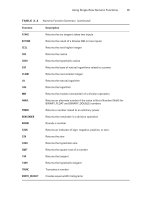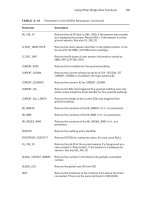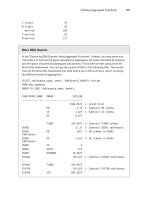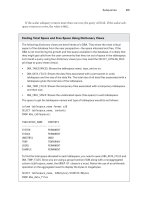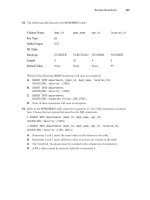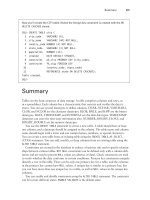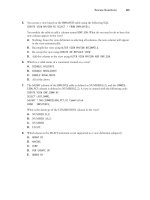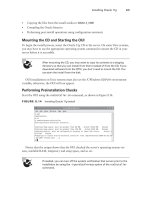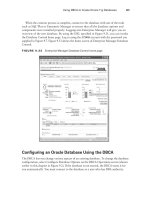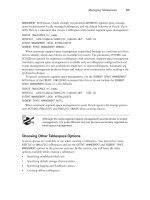Tài liệu OCA: Oracle Database 11g Administrator Certified Associate Study Guide- P14 pptx
Bạn đang xem bản rút gọn của tài liệu. Xem và tải ngay bản đầy đủ của tài liệu tại đây (1.12 MB, 50 trang )
Working with Schema Objects
581
3 FROM USER_CONSTRAINTS
4 WHERE TABLE_NAME LIKE ‘CUST%’;
CONSTRAINT_NAME C TABLE_NAME R_CONSTRAINT_NAME
-------------------- - -------------------- --------------------
SYS_C002792 C CUSTOMER_ADDRESSES
SYS_C002793 C CUSTOMER_ADDRESSES
SYS_C002794 C CUSTOMER_ADDRESSES
SYS_C002795 C CUSTOMER_ADDRESSES
PK_CUST_ADDRESSES P CUSTOMER_ADDRESSES
FK_CUST_ADDRESSES R CUSTOMER_ADDRESSES PK_CUSTOMER_MASTER
CK_ADD_TYPE2 C CUSTOMER_ADDRESSES
CK_ADD_TYPE C CUSTOMER_MASTER
PK_CUSTOMER_MASTER P CUSTOMER_MASTER
UQ_CUST_EMAIL U CUSTOMER_MASTER
PK_CUST_REFS P CUSTOMER_REFERENCES
SYS_C002804 R CUSTOMER_REFERENCES PK_CUSTOMER_MASTER
SYS_C002805 R CUSTOMER_REFERENCES PK_CUSTOMER_MASTER
13 rows selected.
SQL>
SQL> SELECT CONSTRAINT_NAME, GENERATED, INDEX_NAME
2 FROM USER_CONSTRAINTS
3 WHERE TABLE_NAME LIKE ‘CUST%’;
CONSTRAINT_NAME GENERATED INDEX_NAME
-------------------- -------------- --------------------
SYS_C002792 GENERATED NAME
SYS_C002793 GENERATED NAME
SYS_C002794 GENERATED NAME
SYS_C002795 GENERATED NAME
PK_CUST_ADDRESSES USER NAME PK_CUST_ADDRESSES
FK_CUST_ADDRESSES USER NAME
CK_ADD_TYPE2 USER NAME
CK_ADD_TYPE USER NAME
PK_CUSTOMER_MASTER USER NAME PK_CUSTOMER_MASTER
UQ_CUST_EMAIL USER NAME CUST_EMAIL
PK_CUST_REFS USER NAME PK_CUST_REFS
SYS_C002804 GENERATED NAME
SYS_C002805 GENERATED NAME
13 rows selected.
SQL>
95127c10.indd 581 2/17/09 2:00:39 PM
Please purchase PDF Split-Merge on www.verypdf.com to remove this watermark.
582
Chapter 10
N
Allocating Database Storage and Creating Schema Objects
Summary
This chapter discussed the most important aspect of the Oracle Database: storing data.
You learned to create both tablespaces and data files as well as to create schema objects that
store the data. You found out how to create and manage tablespaces as well as how Oracle
stores some schema objects as segments that are comprised of extents and data blocks. In
addition, you learned how to create and modify tables, indexes, and constraints. I also cov-
ered deferred constraint checking and how to configure foreign key constraints to support
either deferrable or not deferrable implementations.
A data file belongs to one tablespace, and a tablespace can have one or more data files.
The size of the tablespace is the total size of all the data files belonging to that tablespace.
The size of the database is the total size of all tablespaces in the database, which is the same
as the total size of all data files in the database. Tablespaces are logical storage units used to
group data depending on their type or category. Understand the relationship between data
files and tablespaces because that is important information to know for the certification.
Tablespaces can handle the extent management through the Oracle dictionary or locally
in the data files that belong to the tablespace. Locally managed tablespaces can have uni-
form extent sizes; this reduces fragmentation and wasted space. You can also make Oracle
do the entire extent sizing for locally managed tablespaces.
A temporary tablespace is used only for sorting; no permanent objects can be created in a
temporary tablespace. Only one sort segment will be created for each instance in the tempo-
rary tablespace. Multiple transactions can use the same sort segment, but one transaction can
use only one extent. Although temporary files are part of the database, they do not appear in
the control file, and the block changes do not generate any redo information because all the
segments created on locally managed temporary tablespaces are temporary segments.
You learned about tables, indexes, and constraints in this chapter. Also study Chapters
6 and 7 before taking the certification exam. Tables are created using the
CREATE TABLE
command. By default, the table will be created in the current schema. To create the table
in another schema, you should qualify the table with the schema name. Storage parameters
can be specified when creating the table. Tables can be moved or reorganized using the
MOVE
clause.
Indexes can be created as B-tree or bitmap. Bitmap indexes save storage space for low-
cardinality columns. You can create reverse key or function-based indexes. An index-
organized table stores the index and row data in the B-tree structure. Tablespace and storage
should be specified when creating indexes. Indexes can be created
ONLINE
; that is, the table
will be available for insert/update/delete operations while the indexing is in progress. The
REBUILD
clause of the
ALTER INDEX
command can be used to move the index to a different
tablespace or to reorganize the index.
Constraints are created on the tables to enforce business rules. There are five types of
constraints:
NOT NULL
,
CHECK
,
UNIQUE
,
PRIMARY
KEY
, and
FOREIGN
KEY
.
The constraints can be created to check the conformance at each SQL statement or when
committing the changes—checking for conformance at each statement is the default. You
can enable and disable constraints. Constraints can be enabled with the
NOVALIDATE
clause
to save time after large data loads.
95127c10.indd 582 2/17/09 2:00:40 PM
Please purchase PDF Split-Merge on www.verypdf.com to remove this watermark.
Exam Essentials
583
Exam Essentials
Know the relationship of data files to tablespaces. Tablespaces are built on one or more
data files—bigfile tablespaces on a single data file and smallfile tablespaces on one or more
data files.
Understand the statements needed to create, modify, and drop tablespaces. Use a
CREATE
TABLESPACE
,
ALTER TABLESPACE
, and
DROP TABLESPACE
statement to create, modify, and
drop a tablespace, respectively.
Know how to take tablespaces offline and what consequences the
OFFLINE IMMEDIATE
option poses. Use an
ALTER TABLESPACE
statement to take a tablespace offline or bring it
online. If you use the
OFFLINE IMMEDIATE
option, you must perform media recovery when
you bring it back online.
Understand the default tablespaces for the database. When the database is created, if you
do not specify the
DEFAULT TABLESPACE
and
DEFAULT TEMPORARY TABLESPACE
clauses, the
SYSTEM
tablespace will be the default for user objects and temporary segments.
Know how to use the EM Database Control to view tablespace information. The EM
Database Control can be used to view tablespace information as well as perform various
administrative tasks. A working knowledge of this tool is required.
Know the difference between segment space management and extent management. E x t e n t
management deals with segment-level space allocations, and segment space management
deals with data block-level space allocations.
Know which initialization parameter controls OMF placement. T h e
DB_CREATE_FILE_
DEST
parameter tells the database where to place Oracle Managed Files.
Know the different types of constraints and which have dependencies with others. T h e r e
are the
CHECK
,
NOT NULL
,
UNIQUE
,
PRIMARY KEY
, and
FOREIGN KEY
constraints. A
PRIMARY
KEY
constraint implicitly includes
NOT NULL
and
UNIQUE
constraints. A
FOREIGN KEY
con-
straint must refer to a
PRIMARY KEY
or
UNIQUE
constraint.
Know the types of indexes and when they are appropriate. B-tree indexes are medium-
to high-cardinality columns in applications in which data can change frequently. Bitmap
indexes are best for low- to medium-cardinality columns in applications that control data
changes, usually in batches.
95127c10.indd 583 2/17/09 2:00:40 PM
Please purchase PDF Split-Merge on www.verypdf.com to remove this watermark.
584
Chapter 10
N
Allocating Database Storage and Creating Schema Objects
Review Questions
1. Which of the following statements about tablespaces is true?
A. A tablespace is the physical implementation of logical structure called a namespace.
B. A tablespace can hold the objects of only one schema.
C. A bigfile tablespace can have only one data file.
D. The SYSAUX tablespace is an optional tablespace created only if you install certain data-
base options.
2. Automatic segment space management on the tablespace causes which of the following
table attributes in that tablespace to be ignored?
A. The whole storage clause
B. NEXT and PCTINCREASE
C. BUFFERPOOL and FREEPOOL
D. PCTFREE and PCTUSED
3. Which is not a type of segment that is stored in a tablespace?
A. Undo
B. Redo
C. Permanent
D. Temporary
4. Can a table name ever include the special metacharacter dollar sign ($)?
A. No
B. Yes
C. Only if the table name is enclosed in double quotes
D. Only if the table name is enclosed in single quotes
5. Which operation can you not do to a table that is created with the following SQL statement?
CREATE TABLE properties
(“Location” NUMBER primary key
,value NUMBER(15)
,lot varchar2(12)
,constraint positive_value check
(value > 0)
);
95127c10.indd 584 2/17/09 2:00:40 PM
Please purchase PDF Split-Merge on www.verypdf.com to remove this watermark.
Review Questions
585
A. Rename the primary key to properties.
B. Insert a null into the value column.
C. Add a column named owner.
D. Rename the index-supporting primary key to properties.
E. None of the above.
6. Which constraint-checking model is the default?
A. Initially immediate and deferrable
B. Initially immediate and not deferrable
C. Initially deferred and not immediately
D. Initially deferrable and not immediate
7. Which allocation unit is the smallest?
A. Data file
B. Extent
C. Data block
D. Segment
8. Which of the following is not a valid Oracle 11g datatype?
A. TIMESTAMP WITH LOCAL TIMEZONE
B. BINARY
C. BLOB
D. UROWID
9. How do you specify that a temporary table will be emptied at the end of a user’s session?
A. Create the temporary table with the ON COMMIT PRESERVE ROWS option.
B. Create the temporary table with the ON DISCONNECT PRESERVE ROWS option.
C. Create the temporary table with the ON DISCONNECT PURGE ROWS option.
D. Create the temporary table with the ON COMMIT DELETE ROWS option.
10. You performed the following statement in the database. What actions can you perform on
the table CUST_INFO in the CUST_DATA tablespace. (Choose all that apply.)
ALTER TABLESPACE CUST_DATA READ ONLY;
A. ALTER TABLE CUST_INFO DROP COLUMN xx;
B. TRUNCATE TABLE CUST_INFO;
C. INSERT INTO CUST_INFO VALUES (…);
D. DROP TABLE CUST_INFO;
E. RENAME CUST_INFO TO CUSTOMER_INFO;
95127c10.indd 585 2/17/09 2:00:40 PM
Please purchase PDF Split-Merge on www.verypdf.com to remove this watermark.
586
Chapter 10
N
Allocating Database Storage and Creating Schema Objects
11. Which statements should be executed to make the USERS tablespace read-only, if the
tablespace is offline? (Choose all that apply.)
A. ALTER TABLESPACE USERS READ ONLY
B. ALTER DATABASE MAKE TABLESPACE USERS READ ONLY
C. ALTER TABLESPACE USERS ONLINE
D. ALTER TABLESPACE USERS TEMPORARY
12. How would you add more space to a tablespace? (Choose all that apply.)
A. ALTER TABLESPACE <TABLESPACE NAME> ADD DATAFILE SIZE <N>
B. ALTER DATABASE DATAFILE <FILENAME> RESIZE <N>
C. ALTER DATAFILE <FILENAME> RESIZE <N>
D. ALTER TABLESPACE <TABLESPACE NAME> DATAFILE <FILENAME> RESIZE <N>
13. The database is using automatic memory management. The standard block size for the
database is 8KB. You need to create a tablespace with a block size of 16KB. Which initial-
ization parameter should be set?
A. DB_8K_CACHE_SIZE
B. DB_16K_CACHE_SIZE
C. DB_CACHE_SIZE
D. None of the above
14. Which data dictionary view can be queried to obtain information about the files that
belong to locally managed temporary tablespaces?
A. DBA_DATA_FILES
B. DBA_TABLESPACES
C. DBA_TEMP_FILES
D. DBA_LOCAL_FILES
15. How would you drop a tablespace if the tablespace were not empty?
A. Rename all the objects in the tablespace, and then drop the tablespace.
B. Remove the data files belonging to the tablespace from the disk.
C. Use ALTER DATABASE DROP <TABLESPACE NAME> CASCADE.
D. Use DROP TABLESPACE <TABLESPACE NAME> INCLUDING CONTENTS.
16. Which command is used to enable the autoextensible feature for a file if the file is already
part of a tablespace?
A. ALTER DATABASE.
B. ALTER TABLESPACE.
C. ALTER DATA FILE.
D. You cannot change the autoextensible feature once the data file created.
95127c10.indd 586 2/17/09 2:00:40 PM
Please purchase PDF Split-Merge on www.verypdf.com to remove this watermark.
Review Questions
587
17. Which statement is true regarding the SYSTEM tablespace?
A. It can be made read-only.
B. It can be offline.
C. Data files can be renamed.
D. Data files cannot be resized.
18. The following statement is issued against the primary key constraint (PK_BONUS) of the
BONUS table. Which statements are true? (Choose all that apply.)
ALTER TABLE BONUS MODIFY CONSTRAINT PK_BONUS DISABLE VALIDATE;
A. No new rows can be added to the BONUS table.
B. Existing rows of the BONUS table are validated before disabling the constraint.
C. Rows can be modified, but the primary key columns cannot change.
D. The unique index created when defining the constraint is dropped.
19. Which clause in the ALTER TABLE command is used to reorganize a table?
A. REORGANIZE
B. REBUILD
C. RELOCATE
D. MOVE
20. Which keyword should be used in the CREATE INDEX command to create a function-based
index?
A. CREATE FUNCTION INDEX
B. CREATE INDEX ORGANIZATION INDEX
C. CREATE INDEX FUNCTION BASED
D. None of the above
95127c10.indd 587 2/17/09 2:00:40 PM
Please purchase PDF Split-Merge on www.verypdf.com to remove this watermark.
588
Chapter 10
N
Allocating Database Storage and Creating Schema Objects
Answers to Review Questions
1. C. Bigfile tablespaces can have only a single data file. The traditional or smallfile
tablespace can have many data files.
2. D. Segment space management refers to free-space management, with automatic segment
space management using bitmaps instead of FREELISTS, PCTFREE, and PCTUSED.
3. B. Redo information is not stored in a segment; it is stored in the redo logs. Undo segments
are stored in the undo tablespace, temporary segments are in the temporary tablespace, and
permanent segments go into all the other tablespaces.
4. B. Objects in an Oracle 11g database can always include letters, numbers, and the charac-
ters $, _, and # (dollar sign, underscore, and number sign). Names can include any other
character only if they are enclosed in double quotes. The character dollar sign is not a spe-
cial metacharacter in an Oracle 11g database.
5. E. You can rename both a constraint and an index to the same name as a table—they are
in separate namespaces. Columns can be added, and owner is a valid column name. If the
check constraint condition evaluates to FALSE, the data value will not be allowed; if the
condition evaluates to either TRUE or NULL, the value is allowed.
6. B. Constraints can be created as deferrable and initially deferred, but deferred constraint
checking is not the default.
7. C. An extent is composed of two or more data blocks; a segment is composed of one or
more extents, and a data file houses all these.
8. B. Although BINARY_FLOAT and BINARY_DOUBLE are valid datatypes, BINARY is not.
9. A. The options for temporary tables are either ON COMMIT DELETE ROWS, which causes the
table to flush at the end of each transaction, or ON COMMIT PRESERVE ROWS, which causes
the table to flush at the end of each session.
10. B, D, E. When a tablespace is read-only, DML operations and operations that affect data
in the table are not allowed. Truncate and drop operations are allowed, and you can also
rename the table using the RENAME statement or the ALTER TABLE statement.
11. C, A. To make a tablespace read-only, all the data files belonging to the tablespace must be
online and available. So, bring the tablespace online and then make it read-only.
12. A, B. You can add more space to a tablespace either by adding a data file or by increasing
the size of an existing data file. Option A does not have a file name specified; it uses the
OMF feature to generate filename.
13. B. DB_CACHE_SIZE doesn’t need to be set for the standard block size since automatic mem-
ory management is used. If you set DB_CACHE_SIZE, its value will be used as the minimum.
DB_16K_CACHE_SIZE should be set for the nonstandard block size. You must not set the
DB_8K_CACHE_SIZE parameter because the standard block size is 8KB.
95127c10.indd 588 2/17/09 2:00:40 PM
Please purchase PDF Split-Merge on www.verypdf.com to remove this watermark.
Answers to Review Questions
589
14. C. Locally managed temporary tablespaces are created using the CREATE TEMPORARY
TABLESPACE command. The data files (temporary files) belonging to these tablespaces are in
the DBA_TEMP_FILES view. The EXTENT_MANAGEMENT column of the DBA_TABLESPACES view
shows the type of the tablespace. The data files belonging to locally managed permanent
tablespaces and dictionary-managed (permanent and temporary) tablespaces can be queried
from DBA_DATA_FILES. Locally managed temporary tablespaces reduce contention on the
data dictionary tables.
15. D. The INCLUDING CONTENTS clause is used to drop a tablespace that is not empty. Oracle
does not remove the data files that belong to the tablespace if the files are not Oracle man-
aged; you need to do it manually using an OS command. Oracle updates only the control
file. To remove the files, you can include the INCLUDING CONTENTS AND DATAFILES clause.
16. A. You can use the ALTER TABLESPACE command to rename a file that belongs to the
tablespace, but all other file-management operations are done through the ALTER DATABASE
command. To enable autoextension, use ALTER DATABASE DATAFILE < FILENAME>
AUTOEXTEND ON NEXT <INTEGER> MAXSIZE <INTEGER>.
17. C. The data files belonging to the SYSTEM tablespace can be renamed when the database is
in the MOUNT state by using the ALTER DATABASE RENAME FILE statement.
18. A, D. DISABLE VALIDATE disables the constraint and drops the index but keeps the con-
straint valid. No DML operations are allowed on the table.
19. D. The MOVE clause is used to reorganize a table. You can specify new tablespace and storage
parameters. Queries are allowed on the table, but no DML operations are allowed during
the move.
20. D. No keyword needs to be specified to create a function-based index other than to specify
the function itself. To permit the Oracle optimizer to use a function-based index, you must
set the parameter QUERY_REWRITE_ENABLED to TRUE and QUERY_REWRITE_INTEGRITY to
TRUSTED.
95127c10.indd 589 2/17/09 2:00:40 PM
Please purchase PDF Split-Merge on www.verypdf.com to remove this watermark.
95127c10.indd 590 2/17/09 2:00:40 PM
Please purchase PDF Split-Merge on www.verypdf.com to remove this watermark.
Chapter
11
Understanding
Network Architecture
ORACLE DATABASE 11g:
ADMINISTRATION I EXAM OBJECTIVES
COVERED IN THIS CHAPTER:
Configuring the Oracle Network Environment
Configure and Manage the Oracle Network
Using the Oracle Shared Server architecture
95127c11.indd 591 2/17/09 2:17:12 PM
Please purchase PDF Split-Merge on www.verypdf.com to remove this watermark.
Networks have evolved from simple terminal-based systems to
complex multi-tiered systems. Today’s networks can comprise
many computers on multiple operating systems using a wide
variety of protocols and communicating across wide geographic areas. Although networks
have become increasingly complex, they also have become easier to use and manage. For
instance, we all take advantage of the Internet without knowing or caring about the com-
ponents that make this communication possible, because the complexity of this huge net-
work is completely hidden from us.
The experienced Oracle database administrator has seen this maturation process in the
Oracle network architecture as well. From the first version of SQL*Net to the latest releases
of Oracle Net, Oracle has evolved its network strategy and infrastructure to meet the
demands of the rapidly changing landscape of network communications.
This chapter highlights the areas you need to consider when implementing an Oracle
network strategy and when managing an Oracle 11g network. I’ll also discuss the most
common network configurations. The chapter introduces the features of Oracle Net—the
connectivity-management software that is the backbone of the Oracle network architecture.
I’ll explain how to configure the main client- and server-side components of Oracle Net,
and I’ll discuss the tools you have at your disposal to perform these tasks.
As the number of users connecting to Oracle Databases in the enterprise grows, the
system requirements of the servers increase—particularly the memory and process require-
ments. When a system starts to encounter these capacity issues, you need to know which
alternatives are available within the Oracle environment that can address the problem. One
configuration alternative that may help to overcome this capacity problem is Oracle Shared
Server.
This chapter also discusses Oracle Shared Server and its benefits. You will learn about
the client connection process and how Oracle Shared Server processes user requests. You
will also learn how to configure Oracle Shared Server.
Introducing Network Configurations
You can select from three basic types of network configurations when designing an Oracle
infrastructure:
Single-tier
Two -tier
n
-tier
95127c11.indd 592 2/17/09 2:17:12 PM
Please purchase PDF Split-Merge on www.verypdf.com to remove this watermark.
Introducing Network Configurations
593
Single-tier is the simplest type. It has been around for years and is characterized by the
use of terminals for serial connections to the Oracle server. The two-tier configuration is
also referred to as the client/server architecture, and more recently the n-tier architecture
has been introduced. Let’s take a look at each of these configuration alternatives.
Single-Tier Architecture
Single-tier architecture was the standard for many years before the birth of the personal
computer. Applications using single-tier architecture are sometimes referred to as green-
screen applications because most of the terminals that used them, such as the IBM 3270,
had green screens. Single-tier architecture is commonly associated with mainframe-type
applications.
This architecture is still in use today for many mission-critical applications, such as
order processing and fulfillment and inventory control, because it is the simplest architec-
ture to configure and administer. Because the terminals are directly connected to the host
computer, the complexities of network protocols and multiple operating systems don’t exist.
When single-tier architecture is used—for example, in mainframes—users interact with
the database using terminals, which are nongraphical, character-based devices. In this
type of architecture, client terminals are directly connected to larger server systems such
as mainframes. All the intelligence exists on the mainframe, and all the processing takes
place there. Simple serial connections also exist on the mainframe. Although no complex
network architecture is necessary, a single-tier architecture is somewhat limiting in terms of
scalability and flexibility (see Figure 11.1).
FIGURE 11.1 Single-tier architecture
MainframeDumb Terminal
Direct Connection
Two-Tier Architecture
Two-tier architecture gained popularity with the introduction of the personal computer
and is commonly referred to as client/server computing. In a two-tier environment, clients
connect to servers over a network using a network protocol, which is the agreed-upon method
for the client to communicate with the server. Transmission Control Protocol/Internet
Protocol (TCP/IP) is a popular network protocol and has become the de facto standard of
network computing. Whether you choose TCP/IP or some other network protocol, both the
client and the server must be able to understand it. Figure 11.2 shows an example of two-
tier architecture.
95127c11.indd 593 2/17/09 2:17:12 PM
Please purchase PDF Split-Merge on www.verypdf.com to remove this watermark.
594
Chapter 11
Understanding Network Architecture
FIGURE 11.2 Two-tier architecture
ServerIntelligent Client PC
Network connection
utilizing a protocol
such as TCP/IP
This architecture has definite benefits over single-tier architecture. First, client/server
computing introduces the graphical user interface (GUI). This interface is easier to under-
stand and learn, and it offers more flexibility than the traditional character-based interfaces
of the single-tier architecture. Also, two-tier architecture allows the client computer to
share the application process load. To a certain degree, this reduces the processing require-
ments of the server.
The two-tier architecture does have some faults, even though at one time, this configu-
ration was thought to be the panacea of all networking architectures. Unfortunately, the
main problem—that being scalability—persists. Notice that the term client/server contains
a slash (/). The slash represents the invisible component of the two-tier architecture and the
one that is often overlooked: the network! The limitation of client/server computing is one
of scalability.
When prototyping projects, many developers fail to consider the network component
and soon find out that what worked well in a small environment does not scale effectively
to larger, more complex systems. The two-tier architecture model was subject to a great
deal of redundancy because application software was required on every desktop. As a
result, many companies end up with bloated computers and large servers that still do not
perform adequately. What is needed is a more scalable model for network communications.
That is what n-tier architecture provides.
n-Tier Architecture
n-tier architecture is the next logical step after two-tier architecture. Instead of dividing
application processing work between a client and a server, you divide the work among
three or more machines. The n-tier architecture introduces middleware components, such
as application servers or web servers, situated between the client and the database server,
which can be used for a variety of tasks, including the following:
Moving data between machines that work with different network protocols
Serving as firewalls that can control client access to the servers
Offloading processing of the business logic from the clients and servers to the middle tier
Executing transactions and monitoring activity between clients and servers to balance
the load among multiple servers
Acting as a gateway to bridge existing systems to new systems
95127c11.indd 594 2/17/09 2:17:13 PM
Please purchase PDF Split-Merge on www.verypdf.com to remove this watermark.
An Overview of Oracle Net Features
595
The Internet is an example of the ultimate n-tier architecture, with the user’s browser
providing a consistent presentation interface. This common interface means less training of
staff and also increases the potential reuse of client-side application components.
n-tier architecture is rapidly becoming the architecture of choice for enterprise networks.
This model is scalable and divides the tasks of presentation, business logic and routing, and
database processing among many machines, which means that this model accommodates
large applications. Many factors are driving n-tier computing, such as the Internet and
Oracle grid computing, which uses a large number of back-end processors to scale database
services and connectivity.
By reducing the processing load on the database servers, those servers can do more work
with the same number of resources. Also, the transaction servers can balance the flow of
network transactions intelligently, and application servers can reduce the processing and
memory requirements of the client (see Figure 11.3).
FIGURE 11.3 Connection requests in n-tier architecture
Application
Server
Database
Server
Client
Internet
HTTP
Request
App
Server
Oracle
Net
RDBMS
Oracle
Net
TCP/IP
An Overview of Oracle Net Features
Oracle Net is the glue that bonds the Oracle network together. It is responsible for handling
client-to-server and server-to-server communications, and it can be configured on the cli-
ent, the middle-tier application, web servers, and the Oracle server.
Oracle Net manages the flow of information in the Oracle network infrastructure. First it
establishes the initial connection to the Oracle server, and then it acts as the messenger, passing
requests from the client back to the server or passing them between two Oracle servers. Oracle
Net handles all negotiations between the client and server during the client connection.
In addition to functioning as an information manager, Oracle Net supports the use of
middleware products such as Oracle Application Server and Oracle Connection Manager.
These products allow n-tier architectures to be used in the enterprise, which increases the
flexibility and performance of application designs.
To provide a further understanding of the features of Oracle Net, the following sections
discuss in detail the five categories of networking solutions that Oracle Net addresses:
Connectivity
Manageability
Scalability
95127c11.indd 595 2/17/09 2:17:13 PM
Please purchase PDF Split-Merge on www.verypdf.com to remove this watermark.
596
Chapter 11
Understanding Network Architecture
Security
Accessibility
Connectivity
A client can interact with an Oracle Database in many ways. A client can be running a PC-
based application or a dumb terminal application, or perhaps the client is connecting to the
database via the Internet. Let’s take a look at how Oracle supports connectivity to the data-
base through these and other interfaces:
Multiprotocol support Oracle Net supports a wide range of industry-standard protocols
such as TCP/IP and named pipes. This support is handled transparently and allows Oracle
Net to connect to a wide range of computers and a wide range of operating environments.
Multiple operating systems Oracle Net can run on many operating systems, from Windows
XP to all variants of Unix to large mainframe-based operating systems. This range allows users
to bridge existing systems to other Unix or PC-based systems, which increases the data access
flexibility of the organization without making wholesale changes to the existing systems.
Java and JDBC Applications written in Java can take advantage of the Java Database
Connectivity (JDBC) drivers provided with Oracle to connect to an Oracle server. The two
basic types of JDBC drivers are JDBC Oracle Call Interface (OCI) and JDBC thin.
The JDBC OCI driver is a client-side installed driver that is used if the Java application is
resident on a client computer. This driver is also called a type II driver because the driver
software is installed on the computer that is using the application. It uses OCI to interact
with the Oracle Net infrastructure. Figure 11.4 shows how a client and server communicate
when using a JDBC OCI connection.
FIGURE 11.4 Oracle JDBC OCI connection
Application
Database
Server
Client
JDBC OCI
Driver
Oracle
Net
RDBMS
Oracle
Net
TCP/IP
Network
In this example, the Java application installed on the client uses the JDBC OCI driver and
Oracle Database server. When an application makes a database request, it uses the JDBC
OCI driver to translate the JDBC calls and send them to Oracle Net. Oracle Net is used on
both the client and the server to broker all communications between the two end points.
The JDBC thin driver is written entirely in Java and, as such, is platform independent.
It does not have to be installed on a client computer (which is why it’s called a thin driver).
The driver interfaces directly with a layer of the Oracle Net infrastructure called the two-
task common layer.
95127c11.indd 596 2/17/09 2:17:13 PM
Please purchase PDF Split-Merge on www.verypdf.com to remove this watermark.
An Overview of Oracle Net Features
597
Manageability
Oracle Net provides a variety of features that allow you to manage the components of an
Oracle network. Let’s review the key manageability features of Oracle Net.
Web Applications
Oracle Net supports a variety of connectivity solutions from a web browser interface. Con-
nections can be made through a middle-tier web or application server or directly from a
web browser to an Oracle service.
When a middle-tier solution is used, the web browser uses HTTP to contact a database
service and request information. Typically, an application or web server receives this request
and hands it off to Oracle Net, which manages the connection between the web server and
the database server. Once the database server receives the connection request, the request is
processed and passed back to the web server. The web server then sends the response to the
client’s web browser. This type of request fulfillment requires that the middle-tier application
server be loaded with the Oracle Net software, but the client does not require any additional
software.
Oracle also supports web connectivity directly from a web client. For example, a Java
applet running within a web browser can use a JDBC driver to connect directly to an Ora-
cle server without the need for an application or web server.
Location Transparency
Oracle Net provides the infrastructure to manage the database location. This is important
especially in large organizations that support many databases and clients. Each database
in the organization is represented as one or more services. Database services are defined by
one or more service names. The actual definition of the service names is managed within
Oracle Net. The definition holds information about the type and location of the service on
the network. This layer of abstraction provides location transparency to the client and cen-
tralizes the management of connection information within Oracle Net, which simplifies the
job of managing the network.
Directory Naming
Directory naming allows service names to be resolved through a centralized naming reposi-
tory. The central repository takes the form of a Lightweight Directory Access Protocol
(LDAP)–compliant server. LDAP is a protocol and language that defines a standard method
for storing, identifying, and retrieving services. It provides a simplified way to manage
directories of information, whether this information is about users in an organization or
Oracle services connected to a network. The LDAP server allows for a standard form of
managing and resolving names in an Oracle environment. The quality of these services
excels because LDAP provides a single, industry-standard interface to a directory service
such as Oracle Internet Directory (OID). By using OID, you ensure the security and reliabil-
ity of the directory information because information is stored in the Oracle Database.
95127c11.indd 597 2/17/09 2:17:13 PM
Please purchase PDF Split-Merge on www.verypdf.com to remove this watermark.
598
Chapter 11
Understanding Network Architecture
Scalability
Many enterprise systems are growing rapidly, supporting larger and larger databases and
user communities. Your network capabilities need to be able to support this growth. Oracle
Net provides features that allow you to expand your network reach and maximize your
system resources to meet these demands.
Oracle Shared Server
Oracle Shared Server is an optional configuration of the Oracle server that allows support
for a large number of concurrent connections without increasing physical resource require-
ments. This is accomplished by sharing resources among groups of users.
Oracle Shared Server is discussed in detail later in the chapter in the
section “An Overview of Oracle Shared Server.”
Connection Manager
Oracle Connection Manager is a middleware solution that provides three additional scal-
ability features:
Multiplexing Connection Manager can group many client connections and send them as a
single multiplexed network connection to the Oracle server. This reduces the total number
of network connections that the server has to manage.
Network access You can configure Connection Manager with rules that restrict access by
IP address. You can set up this rules-based configuration to accept or reject client connec-
tion requests. Also, connections can be restricted by point of origin, destination server, or
Oracle server.
Cross-protocol connectivity This feature allows clients and servers that use different net-
work protocols to communicate. Connection Manager acts as a translator, providing two-
way protocol conversion.
Oracle Connection Manager is controlled by a set of background processes that manage
the communications between clients and servers. Figure 11.5 provides an overview of the
Connection Manager architecture.
Security
The threat of data tampering and database security is an issue of major concern in many
organizations as network systems continue to grow in number and complexity and as users
gain increasing access to systems. Sensitive business transactions are being conducted with
greater frequency and, in many cases, are not protected from unauthorized tampering or
message interception. Oracle Net is capable of providing organizations with a secure net-
work environment to conduct business transactions. I’ll now discuss the tools available in
Oracle 11g to protect sensitive information.
95127c11.indd 598 2/17/09 2:17:13 PM
Please purchase PDF Split-Merge on www.verypdf.com to remove this watermark.
An Overview of Oracle Net Features
599
FIGURE 11.5 Connection Manager architecture
Client Machines
Many Simultaneous
Connections
One Shared Server connection
carrying all of the client requests
CMGW
Process
CMADMIN
Process
Oracle
Server
Oracle Connection
Manager
Oracle server
running Shared Server
Advanced Security
Oracle Advanced Security, formerly known as the Advanced Security Option and the
Advanced Networking Option, not only provides the tools necessary to ensure secure trans-
missions of sensitive information, but it also provides mechanisms to confidently identify
and authenticate users in the Oracle enterprise.
When configured on the client and the Oracle server, Oracle Advanced Security supports
secured data transmissions by encrypting and optionally checksumming the transmission
of information that is sent in a transaction. Oracle supports encryption and checksumming
by taking advantage of industry-standard algorithms, such as RSA RC4, Standard DES and
Triple DES, and MD5 checksumming. These security features ensure that data transmitted
from the client has not been altered during transmission to the Oracle server.
Oracle Advanced Security also gives you the ability to authenticate users connecting to the
Oracle servers. In fact, a number of authentication features ensure that users really are who
they claim to be. These are offered in the form of token cards, which use a physical card and
a user-identifying PIN to gain access to the system; retina scans also supported now, which
uses fingerprint technology to authenticate user connection requests; public key; and certifi-
cate-based authentication.
Firewall Support
Firewalls are an important security mechanism in corporate networks. Firewalls are gener-
ally a combination of hardware and software that is used to control network traffic and
95127c11.indd 599 2/17/09 2:17:14 PM
Please purchase PDF Split-Merge on www.verypdf.com to remove this watermark.
600
Chapter 11
Understanding Network Architecture
prevent intruders from compromising corporate network security. Firewalls fall into two
broad categories:
IP-filtering firewalls IP-filtering firewalls monitor the network packet traffic on IP net-
works and filter out packets that either originated or did not originate from specific groups
of machines. The information contained in the IP packet header is interrogated to obtain
this information. Vendors of this type of firewall include Network Associates and Axent
Communications.
Proxy-based firewalls Proxy-based firewalls prevent information from outside the firewall
from flowing directly into the corporate network. The firewall acts as a gatekeeper, inspect-
ing packets and sending only the appropriate information to the corporate network. This
prevents any direct communication between clients outside the firewall and applications
inside the firewall. Check Point Software Technologies and Cisco are examples of vendors
that market proxy-based firewalls.
Oracle works closely with the vendors of both types of firewalls to ensure support of
database traffic through these types of mechanism. Oracle supplies the Oracle Net Applica-
tion Proxy Kit to the firewall vendors. This product can be incorporated into the firewall
architecture to allow database packets to pass through the firewall and still maintain a high
degree of security.
Know Thy Firewall
It is important to understand your network infrastructure, the network routes you are
using to obtain database connections, and the type of firewall products you are using. In
more than one situation, I’ve seen firewalls cause connectivity issues between a client
and an Oracle server.
For instance, a small patch was applied to a firewall when a friend of mine was working
as a DBA for one of his former employers. In this case, employees started experiencing
intermittent disconnects from the Oracle Database. After many days of investigation and
network tracing, the team pinned down the exact problem. The database team then con-
tacted the firewall vendor, who sent a new patch that corrected the problem.
In another instance, the development staff started experiencing a similar connection
problem. It turned out that the networking routes for the development staff had been
modified to connect through a new firewall, with connections timing out after 20 minutes.
This timeout was too short for this department. Increasing the timeout parameter solved
the problem.
These are examples of the types of network changes you need to be aware of to avoid
unnecessary downtime and to avoid wasting staff time and resources.
95127c11.indd 600 2/17/09 2:17:14 PM
Please purchase PDF Split-Merge on www.verypdf.com to remove this watermark.
